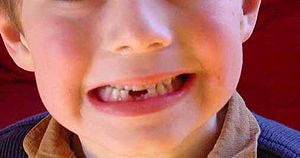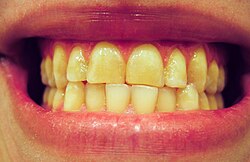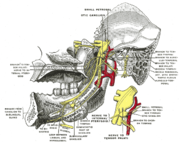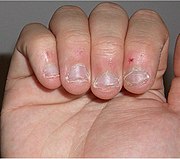 Temporomandibular joint |
Temporomandibular joint disorder (TMJD or TMD), or TMJ syndrome, is an umbrella term covering acute or chronic inflammation of the temporomandibular joint, which connects the mandible to the skull. The disorder and resultant dysfunction can result in significant pain and impairment. Because the disorder transcends the boundaries between several health-care disciplines — in particular, dentistry, neurology, physical therapy, and psychology — there are a variety of treatment approaches.
The temporomandibular joint is susceptible to many of the conditions that affect other joints in the body, including ankylosis, arthritis, trauma, dislocations, developmental anomalies, and neoplasia.
Signs and symptoms
Signs and symptoms of temporomandibular joint disorder vary in their presentation and can be very complex. Often the symptoms will involve more than one of the numerous TMJ components: muscles, nerves, tendons, ligaments, bones, connective tissue, and the teeth. Ear pain associated with the swelling of proximal tissue is a symptom of temporomandibular joint disorder.
Muscles

Disorders of the muscles of the temporomandibular joint are the most common complaints by TMD patients. The two major observations concerning the muscles are pain and dysfunction. The dysfunction can present as trismus or limitation of jaw movement ranging from minor to severe. In milder cases, the only representation may be joint sound such as clicking or popping. These symptoms of TMD are often caused by overusage of the muscles of mastication. Common causes include chewing gum continuously, biting habits (fingernails and pencils), grinding habits, and clenching habits.
Most cases of TMJ, however, are not so simple. Deep-space infections with resulting trismus or neoplams about the joint may mimic TMJ dysfunction. Muscle pain can sometimes be associated with trigger points in muscle tissue. These trigger points can be localized by digital palpation, both intraorally and extraorally. This is known as Myofascial pain syndrome.
Any dysfunction of the muscles may cause the teeth to occlude (bite) with each other incorrectly; if teeth are traumatized by this, they may become sensitive, demonstrating one of the many interplays between muscle, joint, and tooth.
Temporomandibular joints
This is arguably the most complex set of joints in the human body. Unlike typical finger or vertebral junctions, each TMJ actually has two joints, which allow it to both rotate and to translate (slide). With use, it is common to see wear of both the bone and cartilage components of it. Clicking is common, as are popping motions and deviations in the movements of the joint. It is considered a TMJ disorder when pain is involved.
In a healthy joint, the surfaces in contact with one another (bone and cartilage) do not have any receptors to transmit the feeling of pain. The pain therefore originates from one of the surrounding soft tissues. When receptors from one of these areas are triggered, the pain causes a reflex to limit the mandible's movement. Furthermore, inflammation of the joints can cause constant pain, even without movement of the jaw.
Due to the proximity of the ear to the temporomandibular joint, TMJ pain can often be confused with ear pain. The pain may be referred in around half of all patients and experienced as otalgia (earache). Conversely, TMD is an important possible cause of secondary otalgia. Treatment of TMD may then significantly reduce symptoms of otalgia and tinnitus, as well as atypical facial pain. Despite some of these findings, some researchers question whether TMD therapy can reduce symptoms in the ear, and there is currently an ongoing debate to settle the controversy.
The dysfunction involved is most often in regards to the relationship between the condyle of the mandible and the disc. The sounds produced by this dysfunction are usually described as a "click" or a "pop" when a single sound is heard and as "crepitation" or "crepitus" when there are multiple, rough sounds
Teeth
Disorders of the teeth can contribute to TMJ dysfunction. Impaired tooth mobility and tooth loss can be caused by destruction of the supporting bone and by heavy forces being placed on teeth. The movement of the teeth affects how they contact one another when the mouth closes, and the overall relationship between the teeth, muscles, and joints can be altered. Pulpitis, inflammation of the dental pulp, is another symptom that may result from excessive surface erosion. Maybe the most important factor is the way the teeth meet together: the equilibration of forces of mastication and therefore the displacements of the condyle.
Precipitating factors
There are many external factors that place undue strain on the TMJ. These include but are not limited to the following:
Over-opening the jaw beyond its range for the individual or unusually aggressive or repetitive sliding of the jaw sideways (laterally) or forward (protrusive). These movements may also be due to parafunctional habits or a malalignment of the jaw or dentition. This may be due to:
- Trauma
- Repetitive unconscious jaw movements called bruxing.
- Malalignment of the occlusal surfaces of the teeth due to dental defect or neglect.
- Jaw thrusting (causing unusual speech and chewing habits).
- Excessive gum chewing or nail biting.
- Size of foods eaten.
- Degenerative joint disease, such as osteoarthritis or organic degeneration of the articular surfaces, recurrent fibrous and/or bony ankylosis, developmental abnormality, or pathologic lesions within the TMJ
- Myofascial pain dysfunction syndrome
- Lack of Overbite
Treatment
Restoration of the occlusal surfaces of the teeth
If the occlusal surfaces of the teeth or the supporting structures have been damaged due to dental neglect, periodontal diseases or trauma, the proper occlusion should be restored.
Pain relief
While conventional analgesic pain killers such as paracetamol (acetaminophen) or NSAIDs provide initial relief for some sufferers, the pain is often more neuralgic in nature, which often does not respond well to these drugs.
An alternative approach is for pain modification, for which off-label use of low-doses of Tricyclic antidepressant that have anti-muscarinic properties (e.g. Amitriptyline or the less sedative Nortriptyline) generally prove more effective.
Long-term approach
It is suggested that before the attending dentist commences any plan or approach utilizing medications or surgery, a thorough search for inciting para-functional jaw habits must be performed. Correction of any discrepancies from normal can then be the primary goal.
An approach to eliminating para-functional habits involves the taking of a detailed history and careful physical examination. The medical history should be designed to reveal duration of illness and symptoms, previous treatment and effects, contributing medical findings, history of facial trauma, and a search for habits that may have produced or enhanced symptoms. Particular attention should be directed in identifying perverse jaw habits, such as clenching or teeth grinding, lip or cheek biting, or positioning of the lower jaw in an edge-to-edge bite. All of the above strain the muscles of mastication (chewing) and results in jaw pain. Palpation of these muscles will cause a painful response.
Treatment is oriented to eliminating oral habits, physical therapy to the masticatory muscles, and alleviating bad posture of the head and neck. A flat-plane full-coverage oral appliance, e.g. a non-repositioning stabilization splint, often is helpful to control bruxism and take stress off the temporomandibular joint, although some individuals may bite harder on it, resulting in a worsening of their conditions. The anterior splint, with contact at the front teeth only, may then prove helpful. This method of treatment is often referred to as "splint therapy."
According to the National Institute of Dental and Craniofacial Research (NIDCR) of the National Institutes of Health (NIH), TMJ treatments should be reversible whenever possible. That means that the treatment should not cause permanent changes to the jaw or teeth.Examples of reversible treatments are:
- Over-the-counter pain medications, used according to manufacturers’ instructions.
- Prescription medications prescribed by a healthcare provider.
- Gentle jaw stretching and relaxation exercises you can do at home. Your healthcare provider can recommend exercises for your particular condition, if appropriate.
- Feldenkrais TMJ Program, uses a unique understanding of human neurology to reduce chronic tension in the jaw, face, neck, and upper back, and to reverse long-standing movement habits responsible for the original TMJ symptoms.
- Stabilization splint (biteplate, nightguard) is the most widely used treatment for TMJ and jaw muscle problems; however, the actual effectiveness of these splints is unclear. If an oral splint is recommended, it should be used only for a short time and should not cause permanent changes in the bite. If a splint causes or increases pain, stop using it and tell your healthcare provider. Avoid using over-the-counter mouthguards for TMJ treatment. If a splint is not properly fitted, the teeth may shift and worsen the condition.
- Mandibular Repositioning Devices can be worn for a short time to help alleviate symptoms related to painful clicking when opening the mouth wide, but 24-hour wear for the long term may lead to changes in the position of the teeth that can complicate treatment. A typical long-term permanent treatment (if the device is proven to work especially well for the situation) would be to convert the device to a flat-plane bite plate fully covering either the upper or lower teeth and to be used only at night.
What may be concluded is that there are various treatment modalities which a well-trained experienced dentist may employ to relieve symptoms and improve joint function. They include:
- Manual adjustment of the bite by grinding the teeth
- Mandibular repositioning splints which move the jaw, ligaments and muscles into a new position and myofunctional therapy
- Reconstructive dentistry
- Orthodontics
- Arthrocentesis (joint irrigation)
- Surgical repositoning of jaws to correct congenital jaw malformations such as prognathism and retrognathia
- Replacement of the jaw joint(s) or disc(s) with TMJ implants (This should be considered only as a treatment of last resort.)
Attempts in the last decade to develop surgical treatments based on MRI and CAT scans now receive less attention. These techniques are reserved for the most recalcitrant cases where other therapeutic modalities have changed. Exercise protocols, habit control, and splinting should be the first line of approach, leaving oral surgery as a last resort. Certainly a focus on other possible causes of facial pain and jaw immobility and dysfunction should be the initial consideration of the examining oral-facial pain specialist, oral surgeon or health professional. One option for oral surgery, is to manipulate the jaw under general anaesthetic and wash out the joint with a saline and anti-inflammatory solution in a procedure known as arthrocentesis. In some cases, this will reduce the inflammatory process.


















